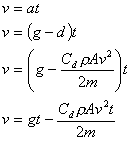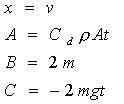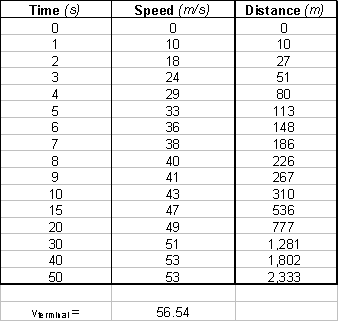

More Info for Propeller Heads
If you really want to know how speed and terminal velocity are calculated (sick! VERY sick!) here is more than you ever wanted to know.
Freefall Speed and Terminal Velocity Derivation
The generalized velocity equation is
![]()
For falling, velocity is determined by the acceleration of gravity, g, reduced by the aerodynamic drag acceleation, d, of the body traveling through the air. So the net acceleration is:
![]()
Aerodynamic drag force is:
![]()
where:
Cd
is the coefficient of drag
r
is the density of air
A
is the frontal area of the body
Generalized force equation:
![]()
where:
F is any force
m
is the mass of the object
We substitute the drag force D for F and the drag acceleration d for a, then solve for the acceleration due to aerodynamic drag:

Now
we may return to the original generalized velocity equation as a function of
time and account for the unique parameters of our free-fall problem:

This
is a quadratic equation in v, which must be solved using the Quadratic
Formula, which states that, given
![]() ,
,
the
solution for x is found by
![]() .
.
Hence,
given

we
may substitute the following

into
the Quadratic Formula and obtain a solution for v as a function of time, t:

In the case where the force of acceleration due to gravity is exactly equal to the resistant force due to aerodynamic drag, the velocity remains constant with time, and this is known as Terminal Velocity. Under these circumstances, the v(t) equation collapses to

So, let’s take a look at the parameters for a human body in a streamlined position, such as a medium-size swimmer in a dive, and calculate speed as a function of time in free-fall. We start with setting values for the parameters:
Cd
=
.5
(an aerodynamic car will be between .32 and .38)
r
=
1.227 kg/m3
(standard atmosphere)
m
=
60 kg
(132 lb)
A
=
.5 m2
g
=
9.806 m/s2
Since v is a function of t, we need to look at a range of time, and finally produce the following results. And, while we’re at it, lets add in the distance traveled in the time.

Other Resources
If you are still interested in
learning more about this subject, try going to ![]() and searching on "terminal velocity", "aerodynamic drag" or
"free-fall".
and searching on "terminal velocity", "aerodynamic drag" or
"free-fall".